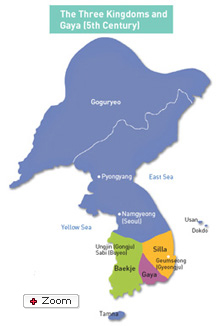 Town-states gradually united into tribal leagues with complex political structures which eventually grew into kingdoms. Among various tribal leagues, Goguryeo (37 B.C.- A.D. 668), situated along the middle course of the Amnokgang (Yalu River), was the first to mature into a kingdom.
Town-states gradually united into tribal leagues with complex political structures which eventually grew into kingdoms. Among various tribal leagues, Goguryeo (37 B.C.- A.D. 668), situated along the middle course of the Amnokgang (Yalu River), was the first to mature into a kingdom.
Goguryeo's aggressive troops conquered neighboring tribes one after another, and in 313, they even occupied China's Lolang outposts.
Baekje (18 B.C.-A.D. 660), which grew out of a town-state located south of the Hangang River in the vicinity of present-day Seoul, was another confederated kingdom similar to Goguryeo. During the reign of King Geunchogo (r. 346-375), Baekje developed into a centralized and aristocratic state.
Silla (57 B.C.-A.D. 935) was located in the southeast corner of the peninsula and was initially the weakest and most underdeveloped of the three kingdoms.
However, because it was geographically removed from Chinese influence, it was more open to non-Chinese practices and ideas. Its society was built on an advanced Buddhist order that was markedly class-oriented, including a military that featured a unique corps of young aristocratic warriors called Hwarang.
Gaya (42-562) began as a type of confederation, formed when several tribes from the Nakdonggang River came together.